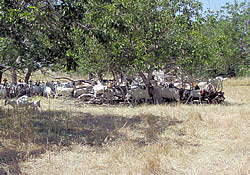Forests and Rangelands Success Story
Goats Help Reduce Risk of Fire in California
Sacramento River and Stone Lakes National Wildlife Refuges, California
Stewardship Contracting - Fuels Reduction
2008

A herd of goats at Sacramento River National Wildlife Refuge in California browse on fire-prone vegetation. Credit: U. S. Fish and Wildlife Service.
With a diet of shrubs, branches, and grass, goats have become a creative tool at the Sacramento River and Stone Lakes National Wildlife Refuges to reduce overgrown vegetation in natural areas. The goats are used in areas near communities, where wildfire could occur and potentially threaten homes. During their recent assignment to the refuges, the goats cleared several hundred acres that would have had to have been thinned manually by handcrews using power tools like chainsaws and heavy equipment.
The refuges, located in northern California, first introduced goats last year to areas at risk of wildfire. "We have been very pleased with the results," said Kelly Moroney, Refuge Manager of the Sacramento National Wildlife Refuge. "The use of goats has been successful at reducing the threat of fire to our neighbors by removing the understory and ladder fuels which allow fire to get into the tree canopies."
Many of the areas where goats are being used are very thick with riparian vegetation which poses a direct fire hazard to adjacent property and homes. The nibbling goats eliminate the vegetation in a natural and safe manner, creating a break in the flammable material that could easily fuel a wildfire. The fuelbreak is easy to maintain and could ultimately help stop or slow a fire from spreading off the refuge to private property and homes.
Along with manual thinning and prescribed fire, goat grazing is part of a combination of methods refuge managers rely on to reduce hazardous fuels and maintain healthy habitat. When compared with other methods of reducing overgrown vegetation, targeted grazing is less expensive, emits no carbon gases, and is a quieter option around populated areas.
"The feedback we have gotten from our neighbors and county public works officials has been very positive," said Moroney. "We intend to keep using them."
This year, the goats will rotate to other portions of the refuges throughout the summer. As many as 300 goats may be placed in an area to graze for up to a week. Handcrews will follow-up the grazing using chainsaws and chippers to cut and eliminate the high branches growing outside the reach of the animals.
The use of goats also reduces concerns with smoke along California’s busy highways, both smoke from the alternate tool of prescribed burning and smoke from any wildfires that are otherwise slowed or stopped. Refuge managers have developed a monitoring program to determine the long-term effectiveness of using goat grazing versus other management techniques.
Both the Sacramento River and Stone Lakes National Wildlife Refuges provide critical winter habitat for migratory birds along the Pacific Flyway.